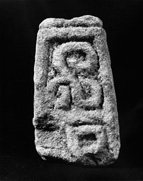Select a site alphabetically from the choices shown in the box below. Alternatively, browse sculptural examples using the Forward/Back buttons.
Chapters for this volume, along with copies of original in-text images, are available here.
Object type: Upper part of cross-shaft
Measurements: H. 26.7 cm (10.5 in); W. 15 > 11.4 cm (6 > 4.5 in); D. 15 > 11.4 cm (6 > 4.5 in)
Stone type: Medium-grained yellow sandstone (Carboniferous)
Plate numbers in printed volume: 371 - 6
Corpus volume reference: Vol 2 p. 118-119
(There may be more views or larger images available for this item. Click on the thumbnail image to view.)
Upper section of the squarish shaft of a composite cross whose lost head was dowelled into the mortise hole on the top of the fragment (face E). Two panels are visible on all faces, each surrounded by a roll moulding. Another roll moulding surrounded the lip of the mortise hole itself. There is a second hole in the base of the fragment (face F).
A (broad): Triskele with pellets in the upper panel and (probably) a recumbent S motif in the panel below.
B (narrow): Swastika, executed in stopped-plait, in the upper panel and a recumbent S-motif in the panel below.
C (broad): Triskele with limbs curved in the same direction (unlike A) in the upper panel and unidentifiable relief carving in panel below.
D (narrow): Upper panel contains a four-limbed motif, whilst the lower contains relief ornament of unidentifiable type.
Spiral-scroll school (Introduction, pp. 33–8). The stopped-plait, swastika, and the use of symbols frequently employed in the spiral-scroll repertoire, allow this fragment to be grouped with other work from that school. The motif on face D may have symbolic value; it is found again in Scotland at Dyce, Aberdeenshire and at Bolton le Moors in Lancashire (Ritchie 1910–11, fig. 2; Allen 1892–5, 142).



